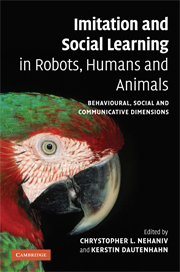 Imitation and Social Learning in Robots, Humans and Animals
Imitation and Social Learning in Robots, Humans and Animals Book contents
- Frontmatter
- Contents
- List of plates
- List of figures
- List of tables
- List of contributors
- Introduction: the constructive interdisciplinary viewpoint for understanding mechanisms and models of imitation and social learning
- Part I Correspondence problems and mechanisms
- Part II Mirroring and ‘mind-reading’
- Part III What to imitate?
- Part IV Development and embodiment
- Part V Synchrony and turn-taking as communicative mechanisms
- Part VI Why imitate? – Motivations
- Part VII Social feedback
- Part VIII The ecological context
- Index
- Plate section
Part V - Synchrony and turn-taking as communicative mechanisms
Published online by Cambridge University Press: 10 December 2009
- Frontmatter
- Contents
- List of plates
- List of figures
- List of tables
- List of contributors
- Introduction: the constructive interdisciplinary viewpoint for understanding mechanisms and models of imitation and social learning
- Part I Correspondence problems and mechanisms
- Part II Mirroring and ‘mind-reading’
- Part III What to imitate?
- Part IV Development and embodiment
- Part V Synchrony and turn-taking as communicative mechanisms
- Part VI Why imitate? – Motivations
- Part VII Social feedback
- Part VIII The ecological context
- Index
- Plate section
Summary
The following three chapters highlight the important role of synchrony and turn-taking in imitative interactions. Two particular aspects are emphasized in this section: firstly, the communicative role and function of imitation which, in particular in research involving robots or other artifacts, has often been neglected in favour of the skill acquisition aspect of imitation, and secondly, the dynamical nature of imitative interactions where synchrony and turn-taking facilitate inter-subjectivity, sharing of experience, communication and empathy.
The first two chapters in this section provide excellent examples of Braitenberg's synthetic psychology approach (Braitenberg, 1984) where the synthesis and study of artifacts (simulated agents or robots) can shed light on psychological phenomena that have been observed in humans and other animals. In experiments with artifacts the systems' design parameters as well as input/output characteristics can be accessed directly, which can give rise to studies and types of analysis otherwise impossible with biological systems. Both chapters demonstrate how psychological experiments have led to robotic experiments and computer simulations, whose results in turn can be compared to work in psychology and inform further studies and the development of theoretical frameworks that apply across biological and artificial systems.
Arnaud Revel and Jacqueline Nadel present inter-disciplinary work that compares imitation in human infants and autonomous robots, providing concrete examples from both research areas that are underpinning their framework. The chapter highlights the communicative function of synchronization and turn-taking.
- Type
- Chapter
- Information
- Imitation and Social Learning in Robots, Humans and AnimalsBehavioural, Social and Communicative Dimensions, pp. 275 - 278Publisher: Cambridge University PressPrint publication year: 2007
